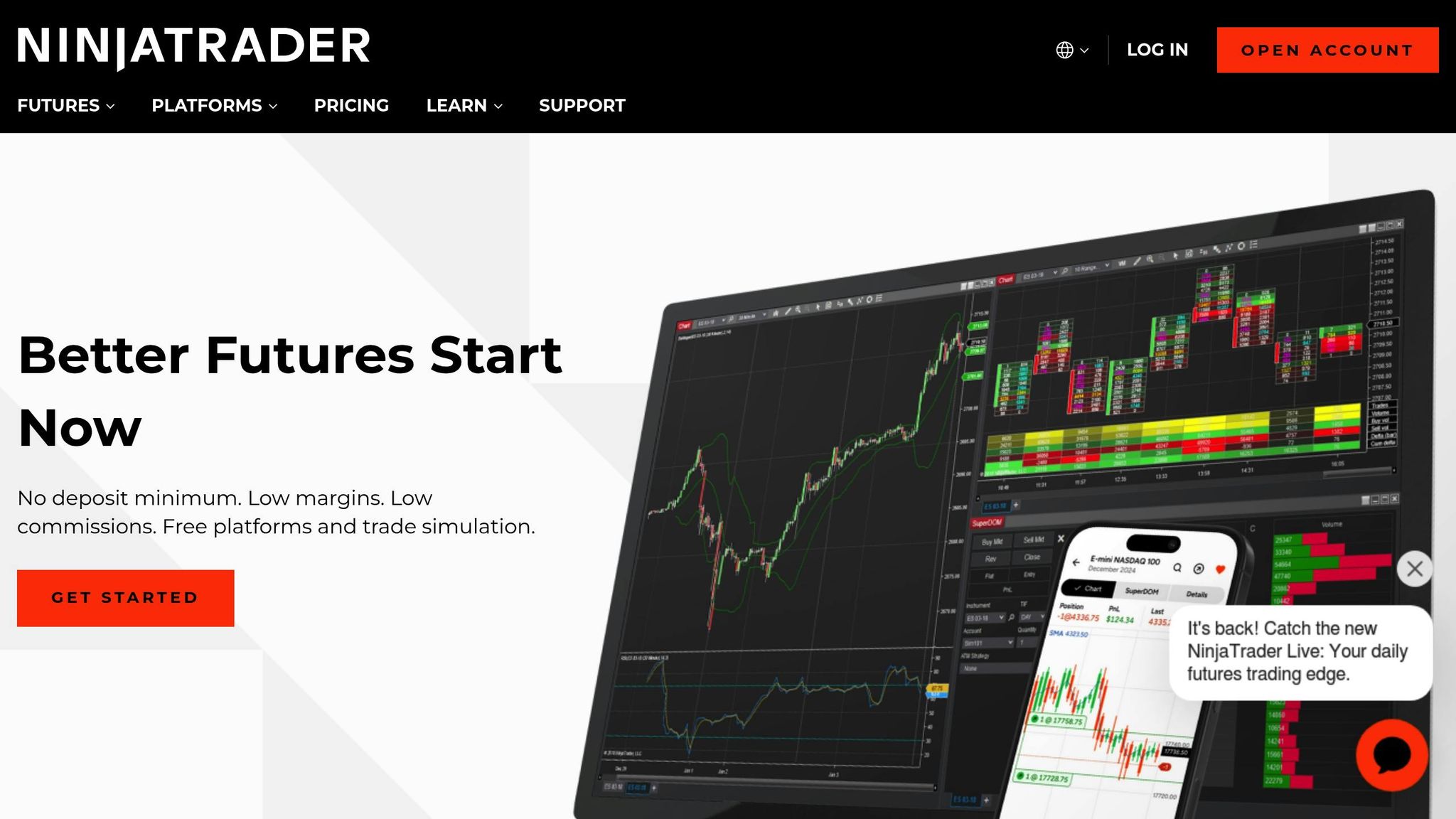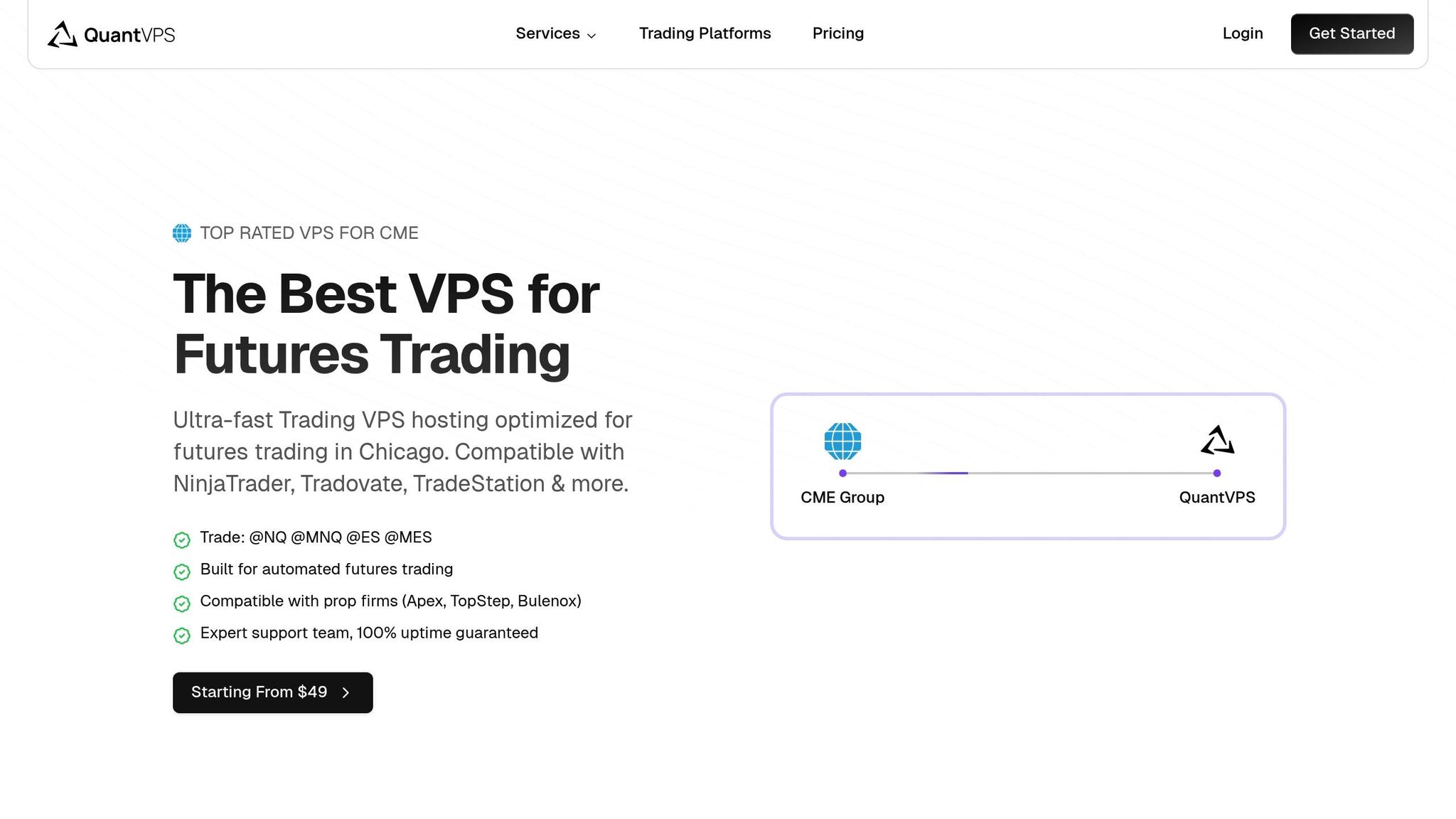In the fast-paced world of CME futures trading, speed and reliability are everything. QuantVPS, co-founded by Ryan, provides ultra-low latency VPS hosting specifically designed for traders using automated strategies on CME markets like ES (E-mini S&P 500) and NQ (E-mini NASDAQ-100) futures. Here’s what you need to know:
Ready to take your CME futures trading to the next level with a serious boost in speed and reliability?
AFFMaven: Check out these specialized VPS solutions that offer sub-millisecond execution times, optimized platform setups, and 99.9% uptime. Read the full interview and listen to the podcast below for even more insider insights, then come back to secure your advantage with cutting-edge technology designed for serious traders.
- Ultra-Low Latency: Achieves 0-1ms latency to CME servers in Chicago through direct network peering.
- Optimized Hardware: Powered by AMD EPYC processors, DDR4 RAM, and NVMe SSDs for seamless performance.
- Pre-Configured Platforms: Supports NinjaTrader, TradeStation, Quantower, and more.
- Reliability: 99.9% uptime with redundant systems to ensure consistent performance.
- AI-Ready: Future-proofed for AI-driven trading strategies, real-time risk management, and predictive analytics.
For CME futures traders, QuantVPS eliminates technical barriers, providing the infrastructure needed for fast, dependable, and efficient trading.
Quick Comparison: Why Low Latency Matters
| Latency Range | Impact on Trading | Best Use Cases |
|---|---|---|
| 0–1ms | Ideal for high-frequency trading | ES, NQ futures |
| 1–5ms | Suitable for medium-frequency | Most futures contracts |
| 5ms+ | Reduces strategy efficiency | Long-term positions only |
QuantVPS is tailored to help traders stay ahead in automated trading by offering cutting-edge infrastructure and AI-ready solutions.
NINJATRADER APP LIVE on Android, iPhone, Tablets, Mac …

Trading Servers in Today’s Markets
In the fast-moving world of futures trading, server performance and location play a key role in the success of automated strategies. As trading technology advances, these factors have become critical for achieving better results.
Why Low Latency Matters
Quick server response times are essential for automated trading strategies to succeed. QuantVPS Co-Founder Ryan puts it plainly: "For CME futures traders, ultra-low latency is the difference between profit and loss." This is especially true for high-volume contracts like ES (E-mini S&P 500) and NQ (E-mini NASDAQ-100) futures.
Here’s how latency impacts trading performance:
| Latency Range | Trading Impact | Market Suitability |
|---|---|---|
| 0–1ms | Ideal for high-frequency trading | ES, NQ futures |
| 1–5ms | Suitable for medium-frequency | Most futures contracts |
| 5ms+ | May reduce strategy efficiency | Long-term positions only |
Achieving these low latency levels requires a carefully designed server setup.
Building the Right Server Setup
Reliable hardware is the backbone of successful trading. A well-optimized server infrastructure ensures the ultra-low latency needed for futures trading.
"Location is critical for futures traders. The closer your VPS is to the CME’s servers in Chicago, the faster your orders reach the exchange."
Key components of a powerful server setup include:
- Hardware: AMD EPYC processors and DDR4 RAM to smoothly handle multiple algorithms at once.
- Network: Direct peering with CME for a stable, ultra-low latency connection.
- Backup Systems: Redundant systems to maintain a 99.9% uptime guarantee.
This setup ensures peak performance, especially during volatile market conditions when quick execution is crucial.
CME Futures Connection Guide

Trading CME Futures requires fast, reliable infrastructure. Understanding the basics of CME’s data center setup is crucial for ensuring smooth and efficient market access.
CME Data Center Basics
The Chicago Mercantile Exchange (CME) operates its main data center in Chicago, making this location a key hub for futures traders. Being physically closer to these servers can significantly improve trading speed and performance.
Here are the core technical requirements for connecting to CME:
| Component | Requirement | Impact |
|---|---|---|
| Network Latency | 0–1ms | Crucial for high-frequency trading |
| Server Location | Chicago-based | Reduces delays in order execution |
| Connection Type | Direct peering | Provides stable and reliable access |
| Bandwidth | 1Gbps+ | Supports multiple simultaneous data feeds |
QuantVPS uses Chicago-based infrastructure to meet these requirements, ensuring traders have efficient access to CME markets.
CME Access Through QuantVPS

QuantVPS is designed to enhance CME connectivity with tailored solutions. It provides pre-configured setups for trading platforms like NinjaTrader and TradeStation, along with dedicated CPU and RAM to handle automated strategies. Real-time monitoring ensures systems run smoothly, even during peak trading periods.
To achieve the best results, traders should configure servers with enough resources to match their trading needs. QuantVPS also offers 99.9% uptime, ensuring consistent and dependable market access, especially during critical market events when every millisecond counts.
Modern Trading Automation
Building on the foundation of ultra-low latency and reliable server setups, automated trading today pushes the limits of technology even further.
Growth of Trading Algorithms
Automated trading now depends on advanced algorithms and high-frequency systems, which demand cutting-edge infrastructure. As trading automation evolves, traders face specific technical requirements to stay competitive:
| Requirement | Specification | Purpose |
|---|---|---|
| Latency | 0-1ms | Critical for real-time execution |
| CPU Cores | 6-24+ | Supports multiple algorithms simultaneously |
| RAM | 16-128GB | Handles complex computations |
| Storage | NVMe SSD | Enables fast data access and logging |
| Network | 1-10Gbps | Processes multiple data feeds efficiently |
Meeting these technical demands requires precise configurations, which are outlined below.
Technical Trading Requirements
Modern automated trading strategies rely heavily on optimized hardware and technical setups. QuantVPS provides specialized solutions tailored to meet these needs.
Key considerations for automated trading include:
- Using high-performance processors, sufficient RAM, and pre-configured platform settings to run multiple trading algorithms smoothly.
- Implementing enterprise-level security measures, such as firewalls and DDoS protection, to safeguard proprietary trading algorithms from external threats.
"Your VPS should amplify your trading, not limit it." – Ryan, Co-founder and CEO of QuantVPS
The rise of AI-powered trading bots has made dependable server infrastructure even more critical. These advanced systems require consistent uptime and strong processing power to perform effectively, especially during volatile market periods.
During high-volume trading, resource monitoring becomes essential. Traders need to ensure their infrastructure can manage peak loads without sacrificing speed or reliability. This is particularly important when running multiple algorithms under varying market conditions.
Next Steps in Trading Tech
Server Tech Updates
The push for faster and more reliable trading systems continues with advancements in AI and analytics. Modern trading servers now incorporate AI to enhance market analysis and decision-making. To keep up, these servers need to handle:
- Complex machine learning models for market insights
- Real-time systems for managing trading risks
- Simultaneous execution of multiple trading algorithms
- High-volume predictive data analysis
Regular updates to both hardware and software are essential to support these demands. These upgrades are paving the way for QuantVPS’s upcoming developments.
QuantVPS Development Plans
QuantVPS is scaling its infrastructure to match the evolving needs of trading technology.
"AI is revolutionizing futures trading, particularly on CME contracts like ES and NQ. It’s driving smarter automated strategies, real-time risk management, and predictive market analysis." – Ryan, Co-founder and CEO of QuantVPS
The platform is prioritizing the following key areas for improvement:
| Feature Category | Planned Improvements | Expected Impact |
|---|---|---|
| AI & Risk Management | Upgraded processing for AI-driven strategies and real-time risk monitoring | Faster execution and improved trade safety |
| Data Processing | Expanded NVMe storage for handling large datasets | Improved management of historical market data |
| Network Infrastructure | More low-latency connections | Shorter execution times for automated trades |
These upgrades aim to address the increasing complexity of today’s trading systems, especially those relying on AI for analyzing markets and executing trades. QuantVPS is committed to delivering high performance while embracing cutting-edge technology.
Key Interview Points
During our conversation with Ryan, he highlighted the technical choices behind QuantVPS and how they ensure seamless futures trading operations.
"QuantVPS stands apart by being laser-focused on the needs of futures traders, especially those active in CME markets. We’re not a one-size-fits-all VPS – we’ve built our infrastructure for the demands of trading ES and NQ futures, offering sub-millisecond latency to CME servers and dedicated resources for automated strategies." – Ryan, Co-founder and CEO of QuantVPS
QuantVPS achieves 99.9% uptime through redundant systems, ensuring consistent performance even during periods of high market volatility.
As the trading landscape evolves, QuantVPS is preparing to support AI-powered trading strategies:
"At QuantVPS, we see AI as the next frontier for traders. Our high-performance servers are already ideal for hosting AI-driven bots, and we’re exploring tools to help optimize strategies or manage risk on ES and NQ trades. The future of futures trading is AI-powered, and we’re ready to support it." – Ryan, Co-founder and CEO of QuantVPS
Here’s a breakdown of the key factors that define QuantVPS’s approach:
| Factor | Implementation | Impact |
|---|---|---|
| Location | Chicago data centers | Low latency to CME markets |
| Performance | AMD EPYC processors & DDR4 RAM | Sub-millisecond response times |
| Reliability | Redundant systems | 99.9% guaranteed uptime |








